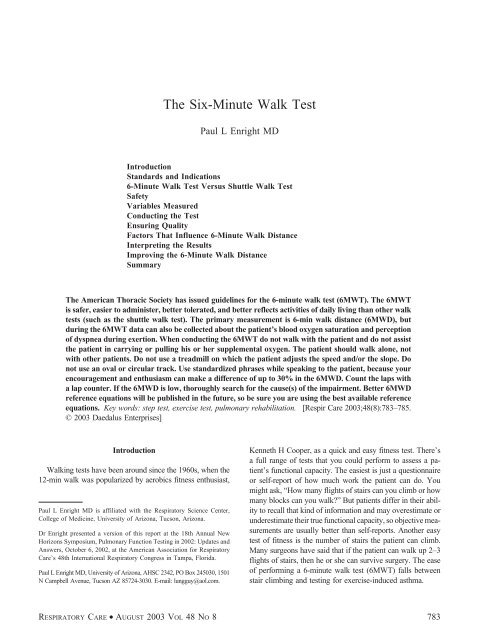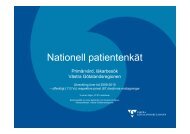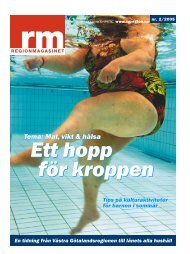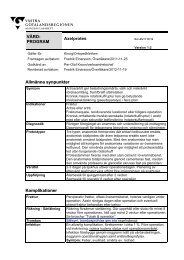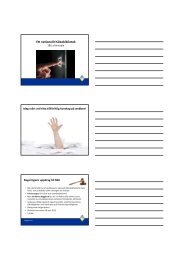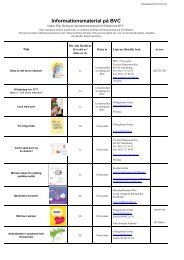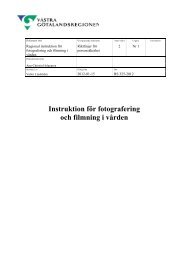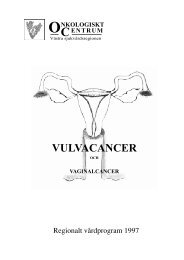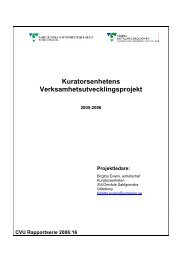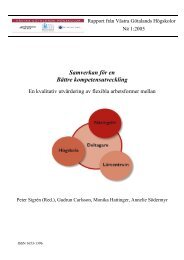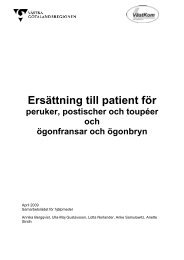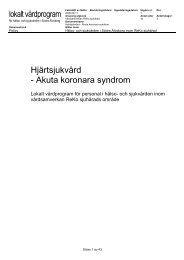The Six-Minute Walk Test
The Six-Minute Walk Test
The Six-Minute Walk Test
You also want an ePaper? Increase the reach of your titles
YUMPU automatically turns print PDFs into web optimized ePapers that Google loves.
<strong>The</strong> <strong>Six</strong>-<strong>Minute</strong> <strong>Walk</strong> <strong>Test</strong><br />
Paul L Enright MD<br />
Introduction<br />
Standards and Indications<br />
6-<strong>Minute</strong> <strong>Walk</strong> <strong>Test</strong> Versus Shuttle <strong>Walk</strong> <strong>Test</strong><br />
Safety<br />
Variables Measured<br />
Conducting the <strong>Test</strong><br />
Ensuring Quality<br />
Factors That Influence 6-<strong>Minute</strong> <strong>Walk</strong> Distance<br />
Interpreting the Results<br />
Improving the 6-<strong>Minute</strong> <strong>Walk</strong> Distance<br />
Summary<br />
<strong>The</strong> American Thoracic Society has issued guidelines for the 6-minute walk test (6MWT). <strong>The</strong> 6MWT<br />
is safer, easier to administer, better tolerated, and better reflects activities of daily living than other walk<br />
tests (such as the shuttle walk test). <strong>The</strong> primary measurement is 6-min walk distance (6MWD), but<br />
during the 6MWT data can also be collected about the patient’s blood oxygen saturation and perception<br />
of dyspnea during exertion. When conducting the 6MWT do not walk with the patient and do not assist<br />
the patient in carrying or pulling his or her supplemental oxygen. <strong>The</strong> patient should walk alone, not<br />
with other patients. Do not use a treadmill on which the patient adjusts the speed and/or the slope. Do<br />
not use an oval or circular track. Use standardized phrases while speaking to the patient, because your<br />
encouragement and enthusiasm can make a difference of up to 30% in the 6MWD. Count the laps with<br />
a lap counter. If the 6MWD is low, thoroughly search for the cause(s) of the impairment. Better 6MWD<br />
reference equations will be published in the future, so be sure you are using the best available reference<br />
equations. Key words: step test, exercise test, pulmonary rehabilitation. [Respir Care 2003;48(8):783–785.<br />
© 2003 Daedalus Enterprises]<br />
Introduction<br />
<strong>Walk</strong>ing tests have been around since the 1960s, when the<br />
12-min walk was popularized by aerobics fitness enthusiast,<br />
Paul L Enright MD is affiliated with the Respiratory Science Center,<br />
College of Medicine, University of Arizona, Tucson, Arizona.<br />
Dr Enright presented a version of this report at the 18th Annual New<br />
Horizons Symposium, Pulmonary Function <strong>Test</strong>ing in 2002: Updates and<br />
Answers, October 6, 2002, at the American Association for Respiratory<br />
Care’s 48th International Respiratory Congress in Tampa, Florida.<br />
Paul L Enright MD, University of Arizona, AHSC 2342, PO Box 245030, 1501<br />
N Campbell Avenue, Tucson AZ 85724-3030. E-mail: lungguy@aol.com.<br />
Kenneth H Cooper, as a quick and easy fitness test. <strong>The</strong>re’s<br />
a full range of tests that you could perform to assess a patient’s<br />
functional capacity. <strong>The</strong> easiest is just a questionnaire<br />
or self-report of how much work the patient can do. You<br />
might ask, “How many flights of stairs can you climb or how<br />
many blocks can you walk?” But patients differ in their ability<br />
to recall that kind of information and may overestimate or<br />
underestimate their true functional capacity, so objective measurements<br />
are usually better than self-reports. Another easy<br />
test of fitness is the number of stairs the patient can climb.<br />
Many surgeons have said that if the patient can walk up 2–3<br />
flights of stairs, then he or she can survive surgery. <strong>The</strong> ease<br />
of performing a 6-minute walk test (6MWT) falls between<br />
stair climbing and testing for exercise-induced asthma.<br />
RESPIRATORY CARE • AUGUST 2003 VOL 48 NO 8 783
Standards and Indications<br />
Recently the American Thoracic Society Pulmonary<br />
Function Standards Committee developed guidelines for<br />
the 6MWT in clinical settings. 1 Carl Mottram, a respiratory<br />
therapist working at the Mayo Clinic in Rochester,<br />
Minnesota, helped to review the document. <strong>The</strong> 6MWT<br />
was chosen because it is easier to administer, better tolerated,<br />
and better reflects activities of daily living than other<br />
walk tests. 2<br />
Table 1 lists the indications for the 6MWT, the most<br />
important of which is to measure outcomes before and<br />
after treatment in people with moderate to severe heart<br />
and lung disease. <strong>The</strong> 6MWT can also be used to measure<br />
functional status and for epidemiologic purposes.<br />
A short 6-minute walk distance (6MWD) fairly accurately<br />
predicts morbidity and mortality from heart or<br />
lung disease.<br />
Table 1. Indications for the 6-<strong>Minute</strong> <strong>Walk</strong> <strong>Test</strong><br />
Before-and-After Treatment Comparisons<br />
Lung transplantation or lung resection<br />
Lung volume reduction surgery<br />
Pulmonary rehabilitation<br />
Drug therapy for chronic obstructive pulmonary disease<br />
Pulmonary hypertension<br />
Heart failure<br />
To Measure Functional Status<br />
Chronic obstructive pulmonary disease<br />
Cystic fibrosis<br />
Heart failure<br />
Peripheral vascular disease<br />
In elderly patients<br />
To Predict Hospitalization and Death<br />
From heart failure, chronic obstructive pulmonary disease, or<br />
pulmonary hypertension<br />
6-<strong>Minute</strong> <strong>Walk</strong> <strong>Test</strong> Versus Shuttle <strong>Walk</strong> <strong>Test</strong><br />
How does the 6MWT compare to the shuttle walk test,<br />
which is frequently used in Great Britain? With the 6MWT<br />
the instructions to the patient are to “walk as far as you can<br />
during 6-minutes,” whereas the shuttle walk test pressures<br />
the patient to meet multiple deadlines, according to beeps<br />
from an audio cassette tape. 3 <strong>The</strong> 6MWT is self-paced,<br />
and a patient is probably less likely to push himself beyond<br />
his endurance or through angina or other pain than<br />
during the shuttle walk test. <strong>The</strong> shuttle walk test is better<br />
correlated with peak oxygen uptake, as measured by a full<br />
cardiopulmonary exercise test, but not as many people are<br />
using the shuttle walk test.<br />
THE SIX-MINUTE WALK TEST<br />
Safety<br />
What about safety? Absolute contraindications for the<br />
6MWT include a history of unstable angina or a heart<br />
attack during the previous month. Relative contraindications<br />
include resting tachycardia (heart rate 120 beats/<br />
min) or uncontrolled hypertension. Two large studies of<br />
thousands of elderly people who performed the 6MWT<br />
reported no untoward events. 4,5 A physician need not be<br />
present during the test, but it is recommended that technicians<br />
administering the test be certified in cardiopulmonary<br />
resuscitation and that medications be available to<br />
treat angina, bronchospasm, and severe shortness of breath.<br />
Electrocardiographic and oxygen saturation monitoring are<br />
not necessary, and the patient should not be tethered with<br />
cables during the test.<br />
Variables Measured<br />
What variables can be measured in the 6MWT? <strong>The</strong><br />
primary measurement is the total distance walked. Secondary<br />
measures can include fatigue and dyspnea, measured<br />
with a modified Borg or visual analog scale. Arterial<br />
oxygen saturation can also be measured via pulse oximetry,<br />
as long as the oximeter is portable and not heavy.<br />
However, I have used 3 different pulse oximeters in large<br />
epidemiologic studies during the past 10 years, and I found<br />
an unacceptably high failure rate, due to motion artifact.<br />
For the last 2 studies I chose fourth-generation pulse oximeters<br />
specifically designed to compensate for motion artifact.<br />
<strong>The</strong>y are reliable for determining the oxygen saturation<br />
before and after the 6MWT test, but, in my opinion,<br />
you should be very cautious in interpreting oxygen saturation<br />
readings obtained during exercise.<br />
Conducting the <strong>Test</strong><br />
When you schedule a walk test, ask the patient to wear<br />
comfortable footwear. During the test do not walk with the<br />
patient, because even if you walk behind them, it will alter<br />
their pace. If the patient is using supplemental oxygen<br />
during the walk, don’t help push the oxygen tank or the<br />
6MWD will not be the same as if the patient was pushing<br />
the tank, as he or she would do at home. In one study the<br />
investigators walked 6 people at the same time, which<br />
created competition among the study participants, resulting<br />
in a 30% larger mean 6MWD than tests in which the<br />
patients walked alone. 4<br />
Ensuring Quality<br />
What should you do to obtain good quality results?<br />
Follow the recently published American Thoracic Society<br />
guidelines. 1 Do not use a treadmill or bike on which the<br />
784 RESPIRATORY CARE • AUGUST 2003 VOL 48 NO 8
patient adjusts the speed and/or the slope. Do not walk<br />
with the patient. Do not use an oval or circular track. You<br />
must use standardized phrases for speaking to the patient,<br />
because the amount of encouragement and enthusiasm<br />
given can make a difference of up to 30% in the 6MWD.<br />
Count the laps with a lap counter.<br />
Factors That Influence 6-<strong>Minute</strong> <strong>Walk</strong> Distance<br />
Table 2 lists factors that influence 6MWD. 5 Not surprisingly,<br />
short people and women have a shorter stride<br />
length and therefore have shorter 6MWDs. Older and<br />
heavier subjects usually have reduced muscle mass and,<br />
therefore, shorter 6MWDs, as do those who are less motivated<br />
or have impaired cognition. Arthritis and other<br />
musculoskeletal diseases also decrease the 6MWD.<br />
Table 2. Factors That Affect 6-<strong>Minute</strong> <strong>Walk</strong> Distance<br />
Factors Associated with Shorter 6-<strong>Minute</strong> <strong>Walk</strong> Distance<br />
Shorter height (shorter legs)<br />
Old age<br />
Higher body weight<br />
Female gender<br />
Impaired cognition<br />
Shorter walking corridor (more turns)<br />
Chronic obstructive pulmonary disease, asthma, cystic fibrosis,<br />
interstitial lung disease<br />
Angina, myocardial infarction, congestive heart failure, stroke,<br />
transient ischemic attack, peripheral vascular disease, ankle-arm<br />
index<br />
Arthritis; ankle, knee, or hip injuries; muscle wasting<br />
Factors Associated with Longer 6-<strong>Minute</strong> <strong>Walk</strong> Distance<br />
Taller height (longer legs)<br />
Male gender<br />
High motivation<br />
Patient has previously performed the test<br />
Medication for a disabling disease taken just before the test<br />
Oxygen supplementation<br />
Interpreting the Results<br />
Once you have measured 6MWD for a given patient,<br />
how do you interpret the result? Ideally, you would calculate<br />
the predicted distance using equations from a published<br />
study of healthy people of the same age group,<br />
much like for spirometry tests. Healthy subjects’ 6MWDs<br />
range from 400 to 700 m. However, the few published<br />
studies have all used different methods, and the predicted<br />
distances differ by up to 30% between the studies. 5–7 Look<br />
for better 6MWD reference equations to be published in<br />
the future. A low 6MWD is nonspecific and nondiagnostic<br />
(just like a low maximum voluntary ventilation). If the<br />
THE SIX-MINUTE WALK TEST<br />
6MWD is low, thoroughly search for the cause(s) of the<br />
impairment. <strong>The</strong> following tests may then be helpful: pulmonary<br />
function, cardiac function, ankle-arm index, muscle<br />
strength, nutritional status, orthopedic function, and<br />
cognitive function.<br />
Improving the 6-<strong>Minute</strong> <strong>Walk</strong> Distance<br />
How much will an intervention improve the 6MWD?<br />
One good study showed that an improvement of more than<br />
70 m walked was clinically important to the patients. 8<br />
Mean improvements of 70–170 m (12–40% longer 6MWD)<br />
have been published for various interventions. Supplemental<br />
oxygen for chronic obstructive pulmonary disease and<br />
interstitial lung disease was shown to improve 6MWD,<br />
despite the extra weight of the ambulatory oxygen source.<br />
Lung volume reduction surgery has also been shown to<br />
improve 6MWD. In patients with chronic obstructive pulmonary<br />
disease, inhaled bronchodilators and rehabilitation<br />
programs can increase 6MWD.<br />
Summary<br />
<strong>The</strong> 6MWT is a useful measure of functional capacity,<br />
targeted at people with at least moderately severe impairment.<br />
It has been widely used for measuring the response<br />
to therapeutic interventions for pulmonary and cardiac disease.<br />
<strong>The</strong> new American Thoracic Society guidelines provide<br />
a standardized approach for performing the test.<br />
REFERENCES<br />
1. ATS statement: guidelines for the six-minute walk test. ATS Committee<br />
on Proficiency Standards for Clinical Pulmonary Function<br />
Laboratories. Am J Respir Crit Care Med 2002;166(1):111–117.<br />
2. Solway S, Brooks D, Lacasse Y, Thomas S. A qualitative systematic<br />
overview of the measurement properties of functional walk tests<br />
used in the cardiorespiratory domain. Chest 2001;119(1):256–270.<br />
3. Revill SM, Morgan MDL, Singh SJ, Williams J, Hardman AE. <strong>The</strong><br />
endurance shuttle walk: a new field test for the assessment of endurance<br />
capacity in chronic obstructive pulmonary disease. Thorax<br />
1999;54(3):213–222.<br />
4. Roomi J, Johnson MM, Waters K, Yohannes A, Helm A, Connolly MJ.<br />
Respiratory rehabilitation, exercise capacity and quality of life in chronic<br />
airways disease in old age. Age Ageing 1996;25(1):12–16.<br />
5. Enright PL, McBurnie MA, Bittner V, Tracy RP, McNamara R,<br />
Arnold A, et al. <strong>The</strong> 6 minute walk test: a quick measure of functional<br />
status in elderly adults. Chest 2003;123(2):387–398.<br />
6. Enright PL, Sherrill DL. Reference equations for the six-minute walk<br />
in healthy adults. Am J Respir Crit Care Med 1998;158(5 Pt 1):<br />
1384–1387.<br />
7. Gibbons WJ, Fruchter N, Sloan S, Levy RD. Reference values for a<br />
multiple repetition 6-minute walk test in healthy adults older than 20<br />
years. J Cardiopulm Rehabil 2001;21(2):87–93.<br />
8. Redelmeier DA, Bayoumi AM, Goldstein RS, Guyatt GH. Interpreting<br />
small differences in functional status: <strong>The</strong> <strong>Six</strong> <strong>Minute</strong> <strong>Walk</strong> test<br />
in chronic lung disease patients. Am J Respir Crit Care Med 1997;<br />
155(4):1278–1282.<br />
RESPIRATORY CARE • AUGUST 2003 VOL 48 NO 8 785


